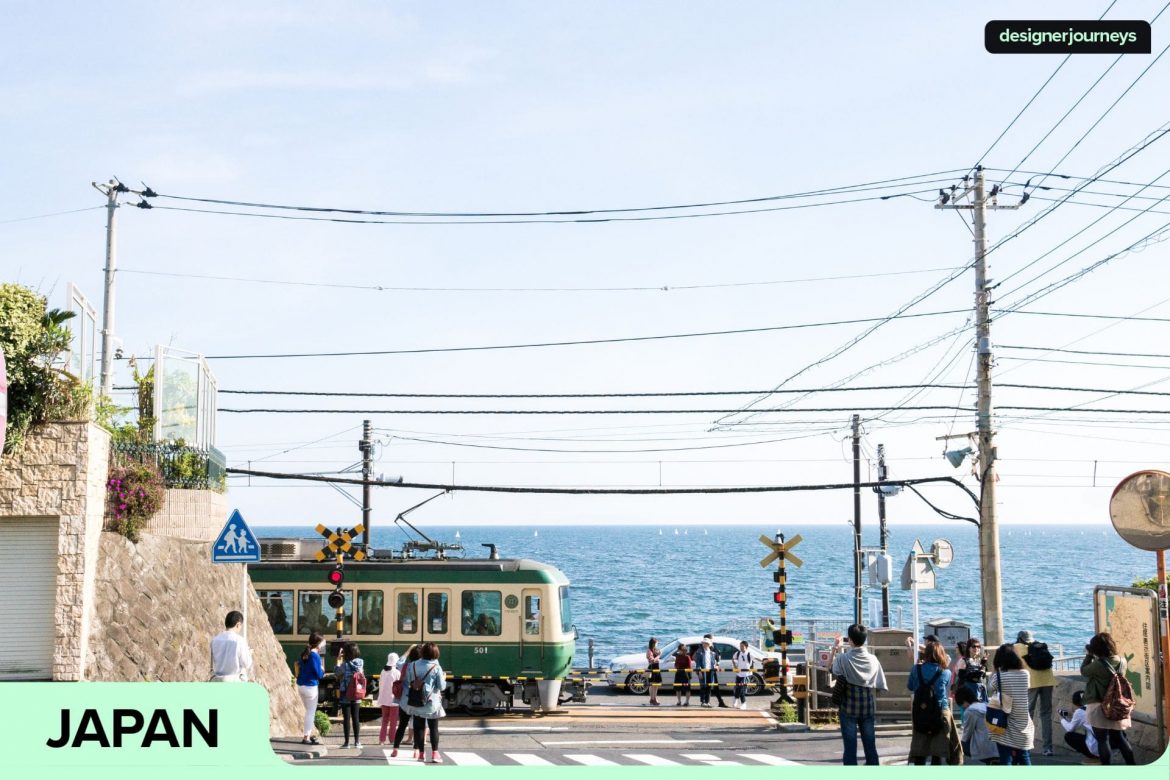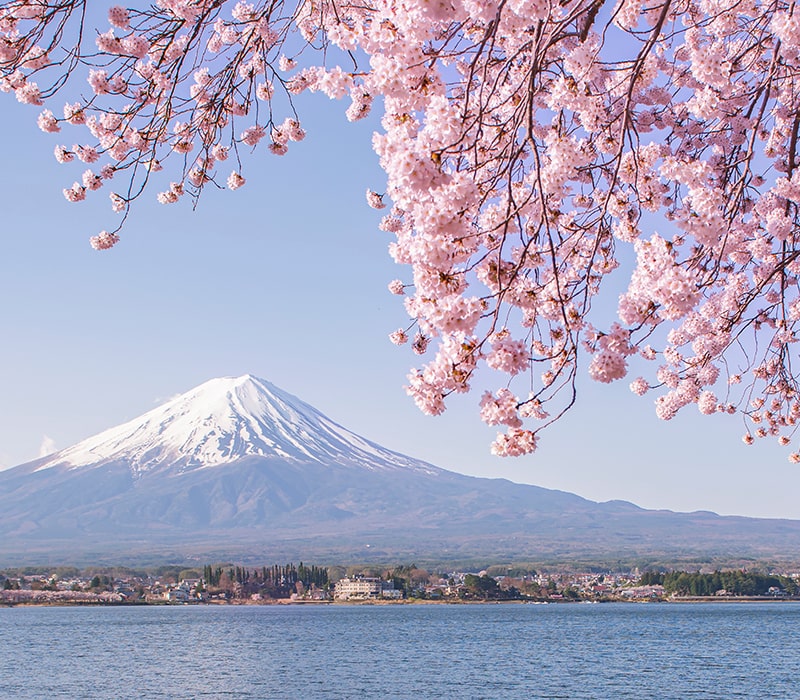Imagine a seaside town where towering bronze Buddha statues meditate beside bamboo gardens, where ancient shrines nestle against dramatic coastal cliffs, and where the whispers of Japan’s former political capital still echo through tranquil streets. Welcome to Kamakura, a captivating destination just an hour south of Tokyo, where profound spirituality, rich history, and natural beauty blend seamlessly into an unforgettable day trip experience, including reverence for the goddess Benzaiten.
This popular destination in Kanagawa Prefecture offers a perfectly crafted introduction to the country’s cultural heart. From Tokyo Station, this coastal gem invites you to explore sacred temple grounds, uncover hidden bamboo forests, and create lasting memories along sandy shores, all while enjoying the confidence that comes with expert local insights and seamless travel experiences.
Post Contents
- Getting There: Your Gateway to Ancient Japan
- The Soul of Kamakura: Sacred Temples and Shrines
- Nature’s Canvas: Gardens, Forests, and Scenic Beauty
- Coastal Splendour: Beaches and Ocean Views
- Local Lifestyle: Street Culture and Culinary Delights
- Unique Cultural Experiences: Traditions Come Alive
- Essential Travel Information for Your Day Trip from Tokyo
- F.A.Qs
- Create Your Perfect Kamakura Experience
Getting There: Your Gateway to Ancient Japan
The journey from Tokyo to this enchanting seaside town begins at Tokyo Station or Shinjuku, where JR lines provide direct access to your Kamakura day trip adventure. The JR Yokosuka Line offers the most convenient route, taking you directly to Kamakura Station in approximately 50 minutes. As you step off the train at the east exit, first impressions reveal a charming blend of modern convenience and traditional atmosphere.
From Kamakura Station, most treasures lie within a short walk, while the historic Enoden train connects you to coastal attractions and Kita-Kamakura Station, where Japan’s most important temples await discovery.
The Soul of Kamakura: Sacred Temples and Shrines
Tsurugaoka Hachimangu Shrine: The Most Important Shrine
At the heart of this historic city stands Tsurugaoka Hachimangu Shrine, the most important shrine in Kamakura and a spiritual centre that has watched over the community since the Kamakura Shogunate established its political capital here in 1185. As you approach through the tree-lined path from Kamakura Station, imagine the countless pilgrims who have made this same journey since the Minamoto clan first built this sacred site.
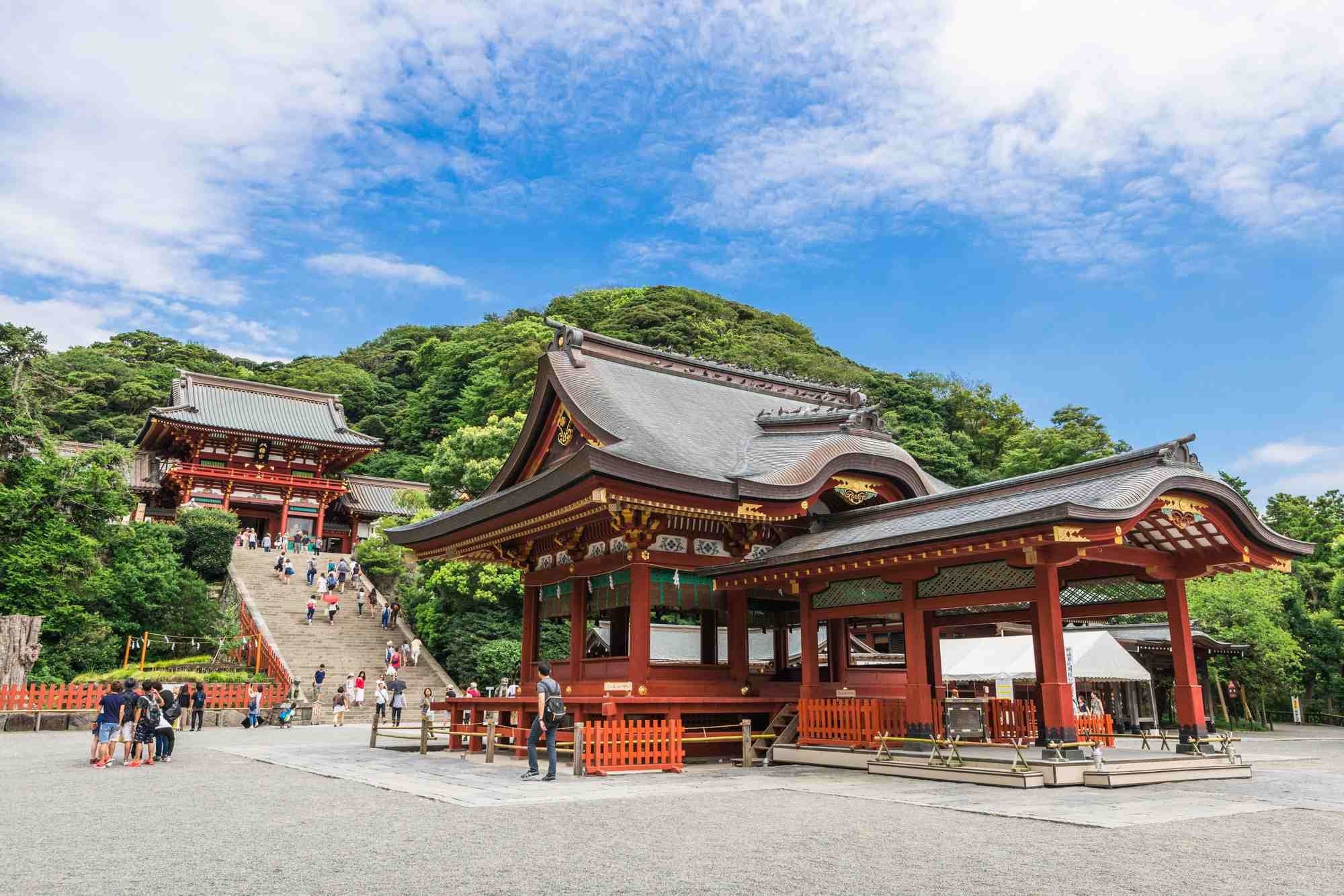
There are two ponds in the complex, popularly called the “Genpei Ponds”.
The shrine grounds offer more than architectural beauty; they provide deep insight into Japan’s unique blend of Shinto traditions and the political power that once emanated from this current site. The elevated main temple hall offers panoramic views across the city, while meticulously maintained gardens showcase seasonal flowers throughout the year, providing a delight for nature lovers. Cherry blossoms paint the complex pink in spring, while autumn transforms the maple trees into brilliant displays.
Practical Information:
- Access: 10-minute walk from Kamakura Station, east exit along the main road
- Hours: 6:00 AM – 9:00 PM (varies by season)
- Admission: Free (some exhibitions charge ¥200)
Hasedera Temple: Garden Paradise and Sacred Statues
Discover the enchanting Hasedera Temple, a short walk from Hase Station on the Enoden Line, where spirituality and natural beauty create profound tranquillity. This temple houses one of Japan’s largest wooden statues of Kannon, the goddess of mercy, carved from a single camphor tree over 1,300 years ago, making it one of the most significant Buddha statues in the region.
The temple grounds feature terraced gardens that are spectacular, particularly during the rainy season (June-July) when over 40 varieties of hydrangeas create a living tapestry of blues, purples, and pinks. From the upper levels, uncover breathtaking views of Sagami Bay that stretch toward distant mountains, offering perfect photo opportunities even when occasional waves crash against the distant shoreline.
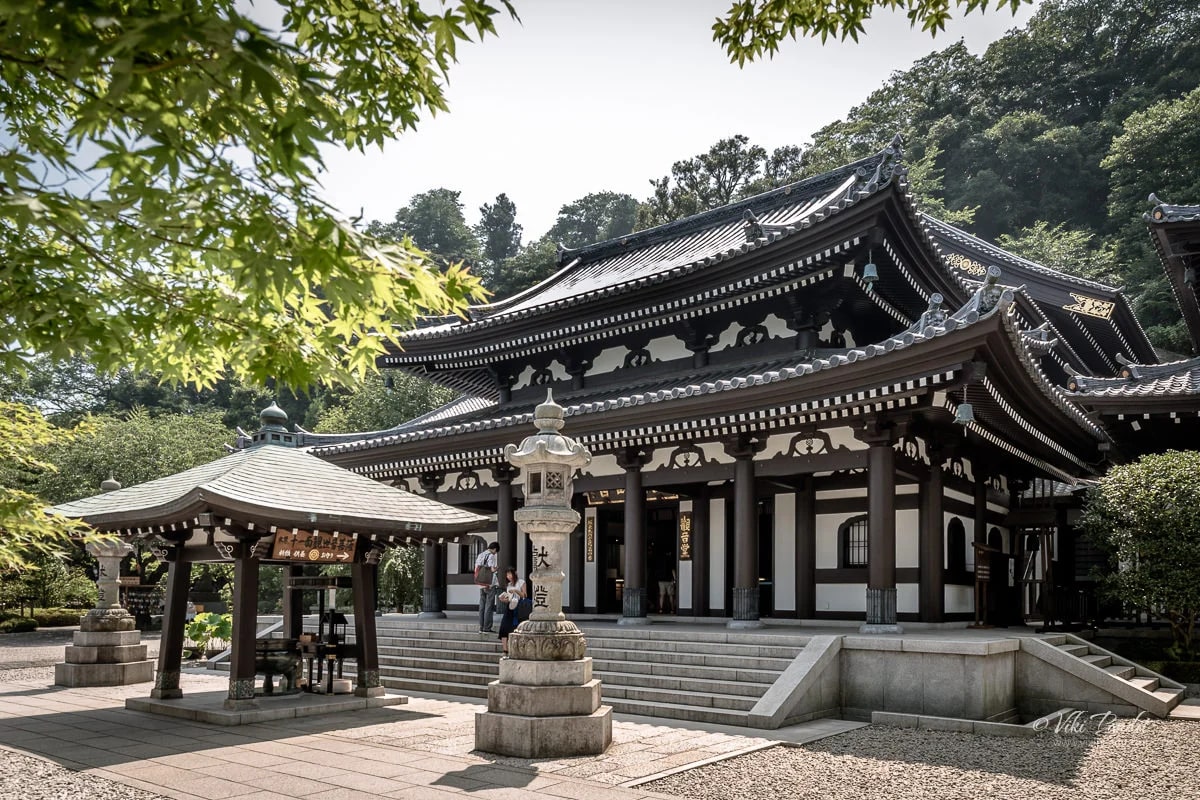
A small cave called Benten-kutsu, dedicated to the goddess Benten.
The temple’s cave system, filled with stone statues, offers a unique underground spiritual experience. A small temple hall within the complex houses additional treasures, while the open-air observation deck provides stunning vistas over this historic seaside town. The temple’s restaurant, overlooking the gardens, serves Buddhist temple cuisine—a mindful dining experience that nature lovers find particularly rewarding.
Practical Information:
- Access: 5-minute walk from Hase Station (Enoden train line)
- Hours: 8:00 AM – 5:30 PM (closes 4:30 PM October-February)
- Admission: ¥400 for adults
Engakuji Temple: Zen Mastery Near Kita-Kamakura Station
Located just steps from Kita-Kamakura Station, Engakuji Temple represents the pinnacle of Zen Buddhist architecture in Japan. Founded in 1282 during the height of the Kamakura Shogunate, this temple complex demonstrates how master craftsmen create harmony between human design and natural landscape. The temple’s Shariden (relic hall) stands as a National Treasure, its elegant proportions telling stories of centuries past.
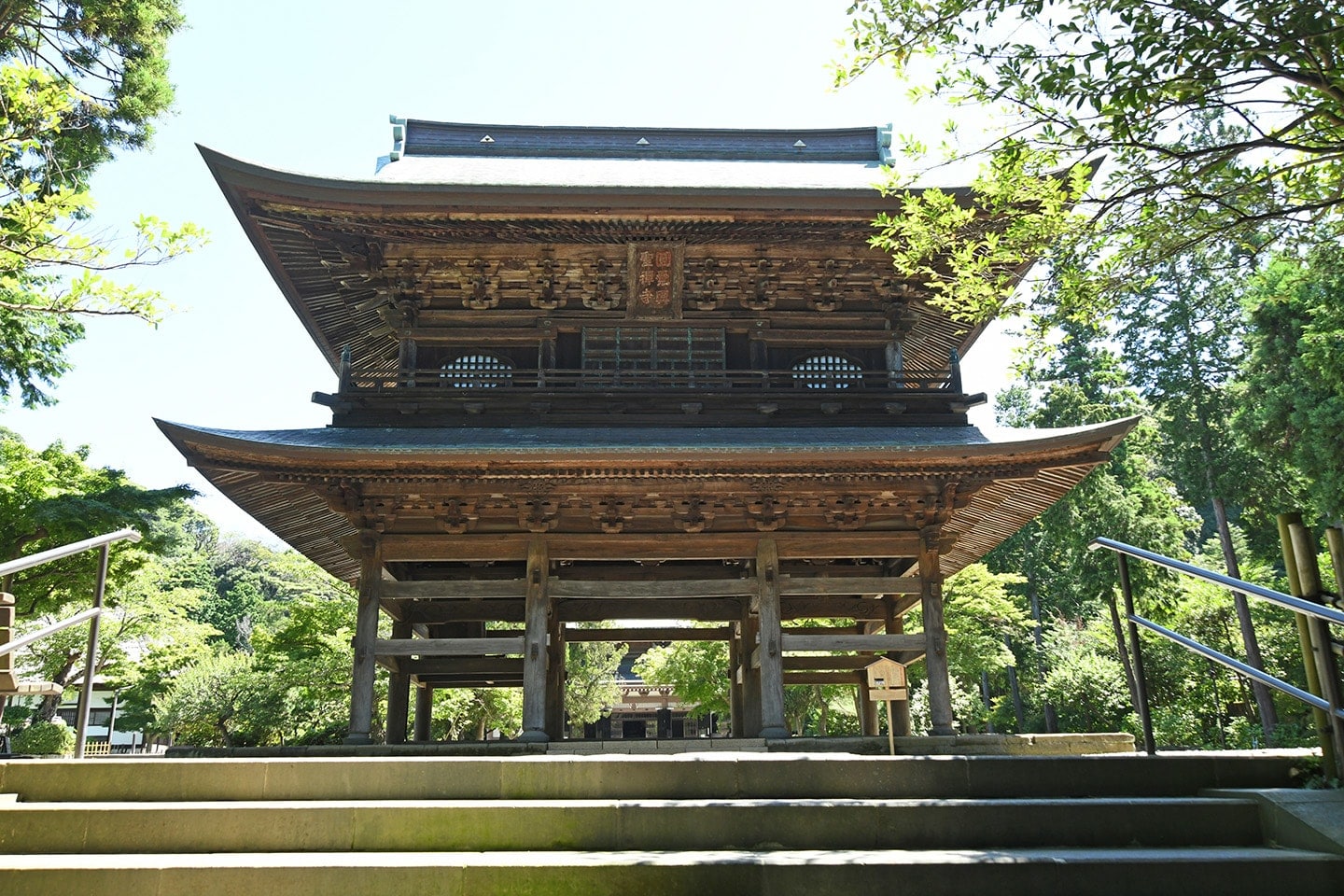
The temple is home to several important cultural properties and national treasures.
Walking through the temple grounds feels like stepping back in time to when this seaside town was the centre of Japanese political and spiritual power. The temple’s location near Kita-Kamakura Station makes it a perfect first stop for visitors taking the JR Yokosuka Line from Tokyo.
Practical Information:
- Access: 1-minute walk from Kita-Kamakura Station
- Hours: 8:00 AM – 4:30 PM (closes 4:00 PM November-March)
- Admission: ¥500 for adults
Kotoku-in Temple: Home of the Great Buddha
No day trip from Tokyo to this historic seaside town is complete without encountering the iconic Great Buddha at Kotoku-in Temple. This bronze colossus, standing 13.35 meters tall and weighing 93 tons, has weathered earthquakes, tsunamis, and centuries of change with serene composure. Cast in 1252 during the Kamakura Shogunate period, the Big Buddha originally resided within a massive wooden hall until natural disasters taught the lesson that some monuments are stronger in the open air.
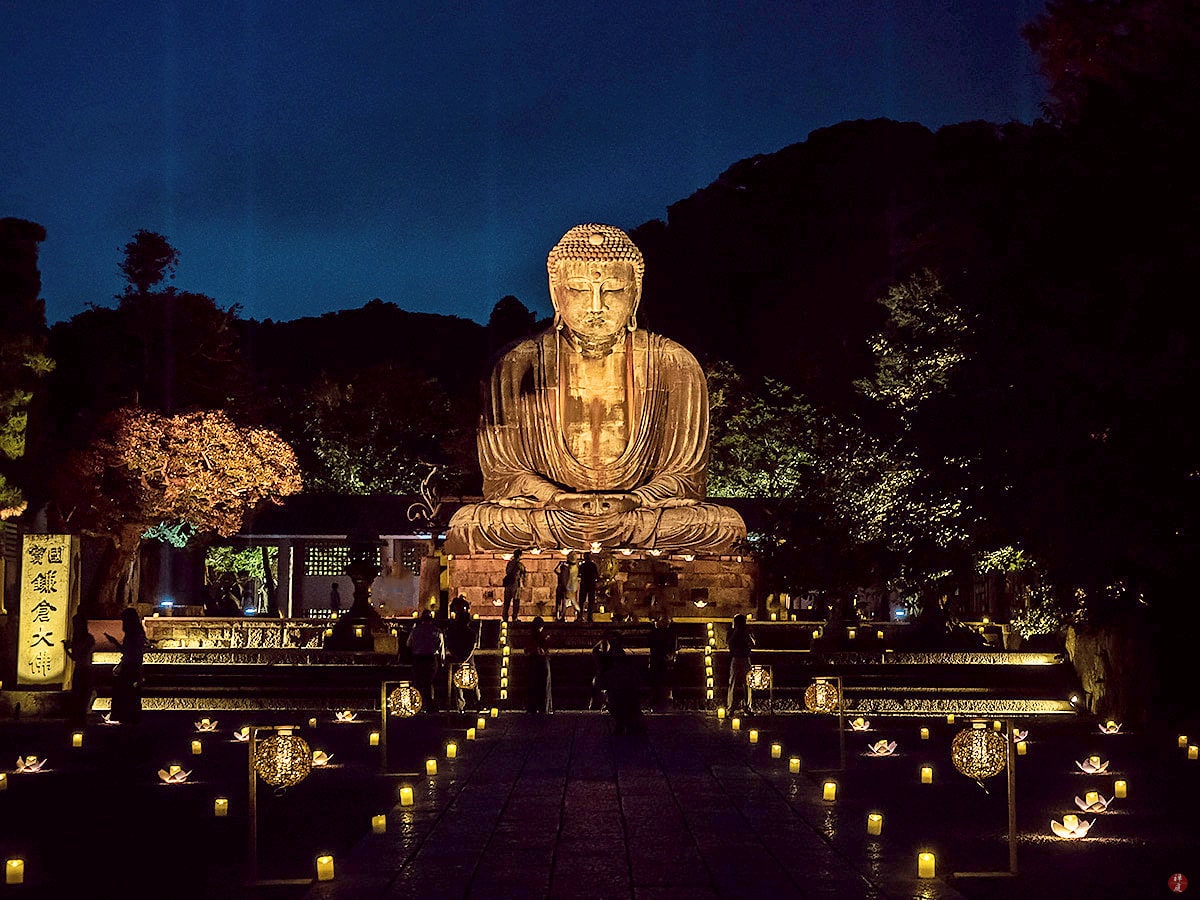
The statue is a designated National Treasure of Japan.
The Great Buddha statue’s hollow interior can be explored for an additional fee, offering a unique perspective on medieval casting techniques that make this one of Japan’s most important Buddha statues. The statue’s peaceful expression continues to inspire contemplation and wonder in millions of visitors who make this popular destination a key stop on their Kamakura day trip.
Practical Information:
- Access: 7-minute walk from Hase Station (Enoden train)
- Hours: 8:00 AM – 5:30 PM (closes 5:00 PM October-March)
- Admission: ¥300 for adults; interior viewing ¥20 additional
Nature’s Canvas: Gardens, Forests, and Scenic Beauty
Bamboo Forest and Gardens: Natural Serenity
Kamakura’s bamboo forest creates natural cathedrals where filtered sunlight dances through towering green columns. The most famous bamboo garden, located at Hokokuji Temple, offers immersive experiences, the gentle rustle of bamboo leaves, the interplay of light and shadow, and profound silence that only nature provides.
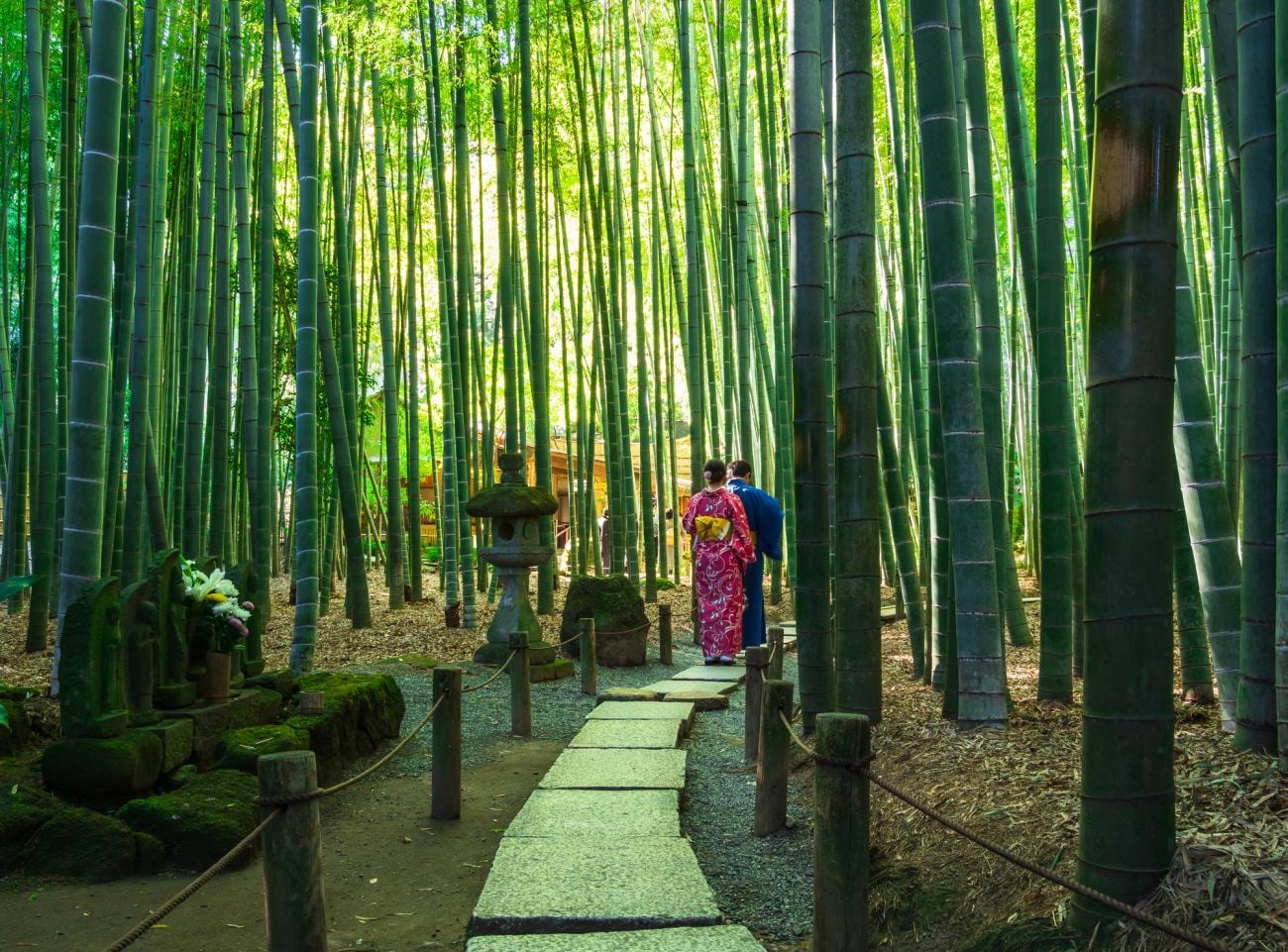
Hokokuji Temple is popularly nicknamed “Bamboo Temple”.
Within the bamboo garden sits a traditional tea house where visitors can enjoy matcha while surrounded by this living architecture. The experience connects you directly with Japanese aesthetic principles that find beauty in simplicity and natural harmony.
Practical Information:
- Access: 12-minute walk from Kamakura Station
- Tea House Hours: 9:00 AM – 4:00 PM
- Admission: ¥300 temple entry; ¥600 for tea ceremony experience
Hiking Trails: Mountain Paths to Enlightenment
Explore Kamakura’s network of hiking trails, which connect temple grounds, offer panoramic views, and provide intimate encounters with the region’s natural beauty. The Daibutsu Hiking Course links major temples through forested paths that samurai once travelled, while the Tenen Hiking Course offers spectacular views of both mountains and Sagami Bay.
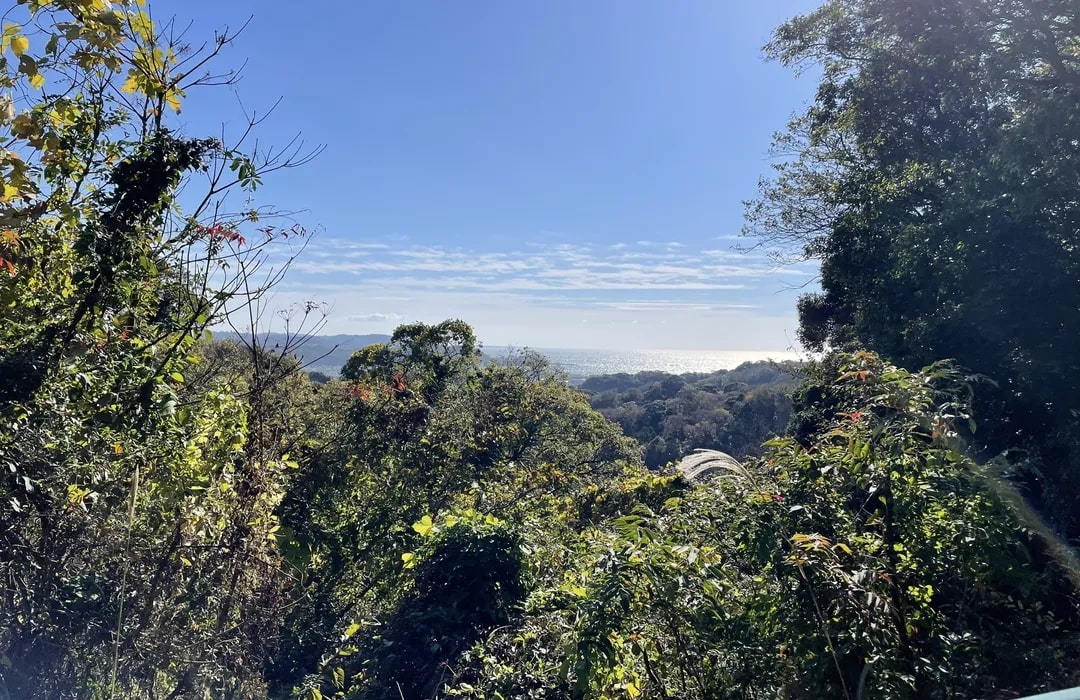
Hiking trails lead through these woods and connect various temples and shrines.
These trails follow routes used by pilgrims and monks for centuries, creating continuity between modern travellers and historical spiritual journeys. From elevated viewpoints, visitors can appreciate how the Kamakura Shogunate strategically positioned their political capital between mountains and sea.
Practical Information:
- Difficulty: Most trails are suitable for moderate fitness levels
- Duration: 2-4 hours, depending on the route
- Best Season: Spring and autumn for optimal weather, accessible year-round except during the heavy rainy season
Gardens and Seasonal Flowers: Living Art Through the Seasons
The temple grounds throughout this seaside town demonstrate Japanese mastery of landscape design, where every element serves both aesthetic and spiritual purposes. These gardens change dramatically with the seasons. Cherry blossoms herald spring’s arrival, while iris and hydrangeas define the rainy season. Autumn maples create fiery displays, and winter’s bare branches reveal architectural elegance.
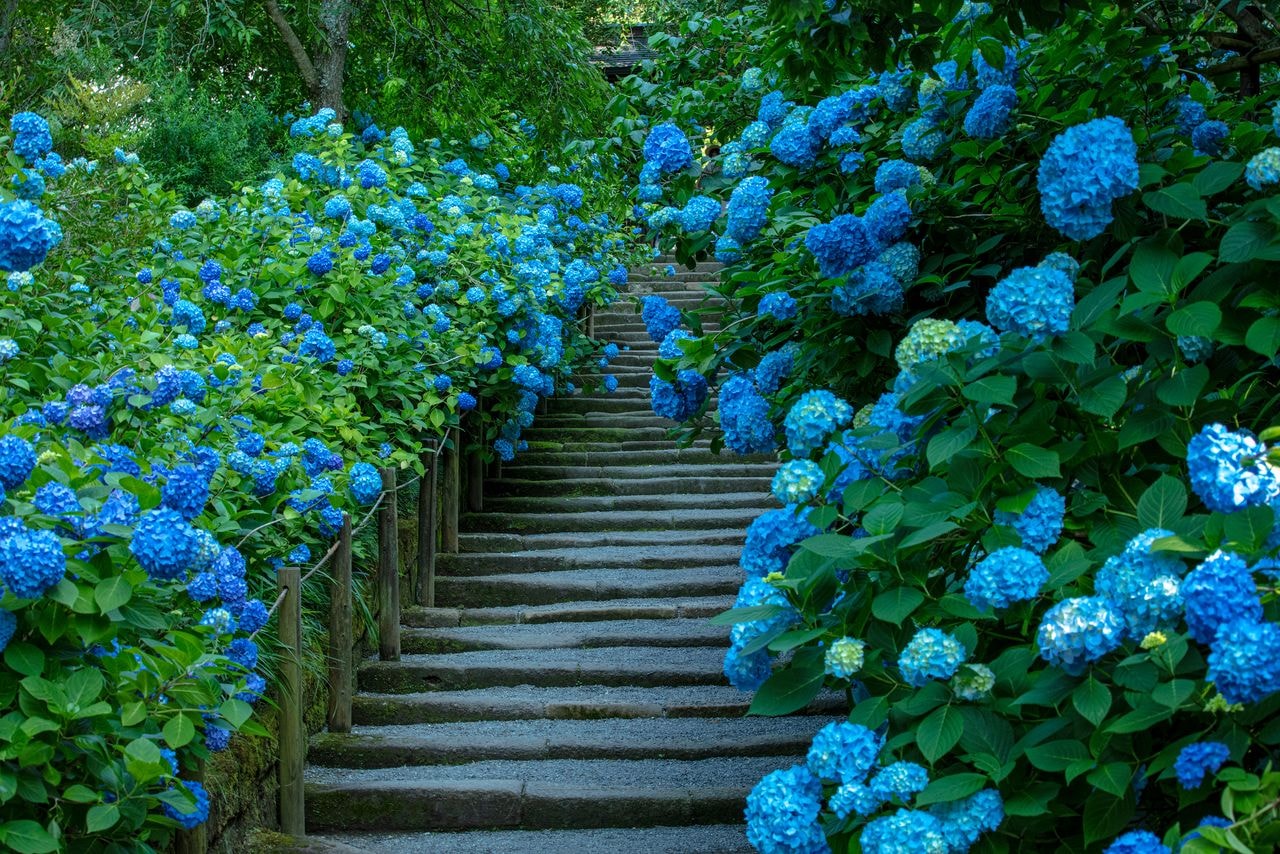
Hasedera Temple is also known as a “Hydrangea Temple” and the “Temple of Flowers”.
The seasonal flowers create constantly changing displays that reward multiple visits throughout the year, making this popular destination equally beautiful whether you visit during cherry blossom season or autumn’s brilliant colours.
Coastal Splendour: Beaches and Ocean Views
Yuigahama Beach: Sandy Shores and Seaside Culture
Yuigahama Beach, the city’s primary stretch of sandy shores, offers a refreshing contrast to the spiritual temple grounds and ancient shrines. This popular beach comes alive during summer with beach shacks serving good food, water sports, and seaside dining that attracts both locals and tourists, providing a perfect pit stop . The beach’s gentle waves and clean facilities make it perfect for relaxation after visiting Buddha statues and temple complexes.
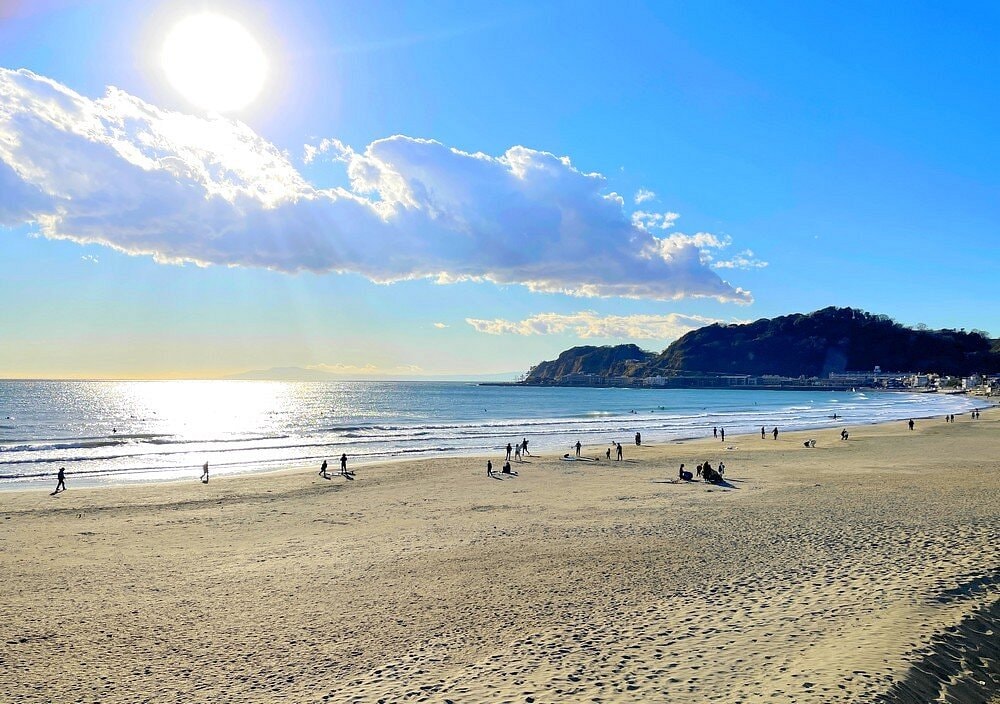
The beach hosts the annual Kamakura Fireworks Festival in July.
During summer months, the beach transforms into a vibrant social centre with temporary structures offering everything from tropical drinks to grilled seafood, creating a perfect pit stop for visitors exploring coastal areas accessible via the Enoden train.
Practical Information:
- Beach Season: July-August (official swimming season)
- Access: 5-minute walk from Hase Station (Enoden line)
- Facilities: Beach shacks, restrooms, shower facilities, equipment rentals
Shichirigahama Beach: Scenic Views and Pop Culture Fame
Shichirigahama Beach offers more dramatic scenery, with its elevated position providing unobstructed views toward Enoshima, a small island visible in the distance, and, on clear days, the majestic outline of Mount Fuji. This beach has gained international recognition as the inspiration for scenes in the beloved “Slam Dunk” manga and anime series, drawing fans worldwide who recreate iconic moments.
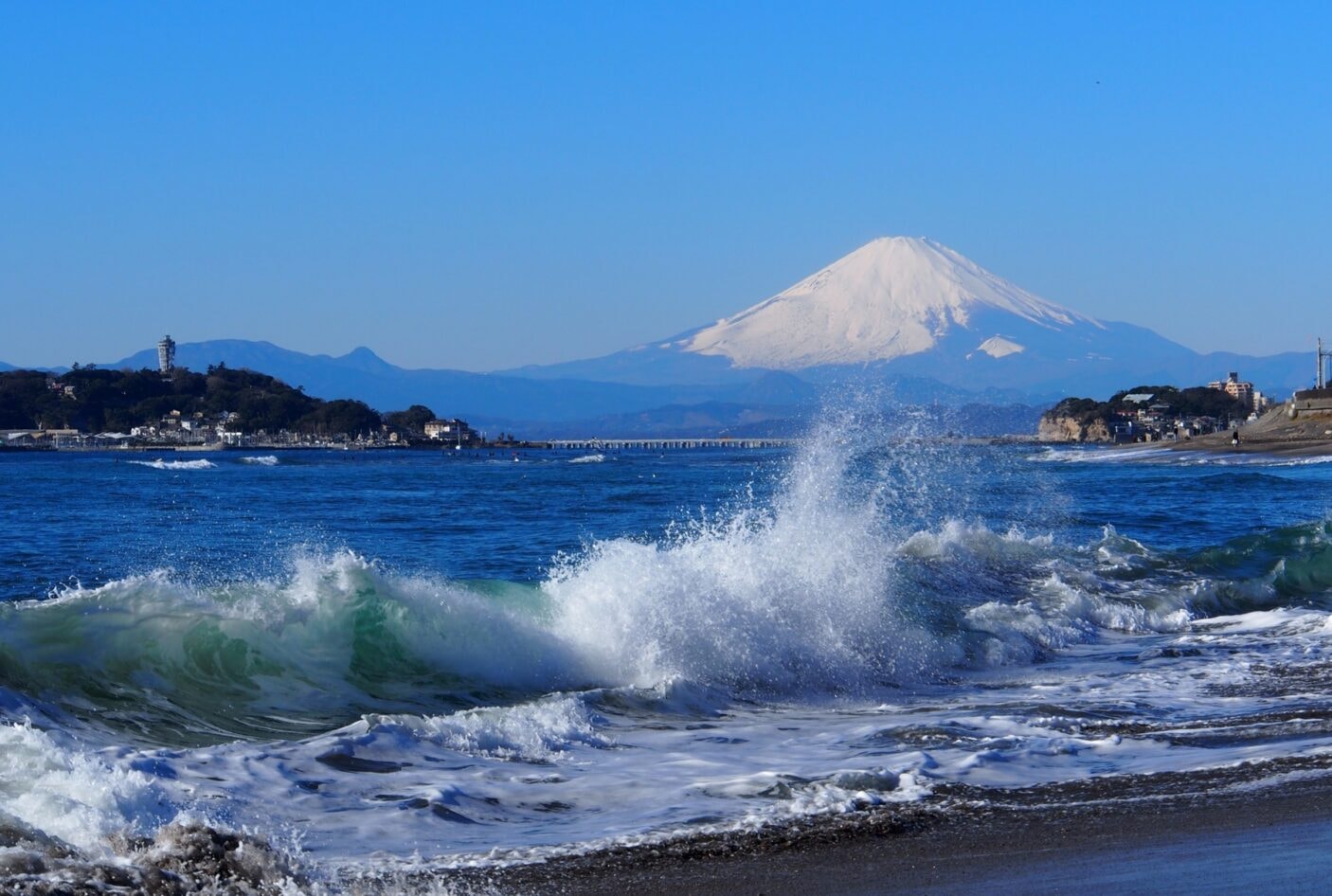
Shichirigahama is a popular spot for surfers year-round due to its waves.
The railway crossing near Shichirigahama Station, with its dramatic ocean backdrop, appears in the series’ opening sequence and demonstrates how contemporary Japanese popular culture continues to celebrate the country’s natural beauty.
Visitor Information:
- Location: Short walk from Shichirigahama Station
- Best Time: Late afternoon for optimal lighting and Mount Fuji visibility
- Access: Enoden train from Kamakura Station
Local Lifestyle: Street Culture and Culinary Delights
Komachi Dori Street: The Pulse of Modern Kamakura
Discover the vibrant energy of Komachi Dori Street, the main pedestrian thoroughfare connecting JR Kamakura Station to Tsurugaoka Hachiman Shrine. This bustling street perfectly balances traditional craftsmanship with contemporary Japanese culture, offering everything from artsy boutiques to innovative street food.
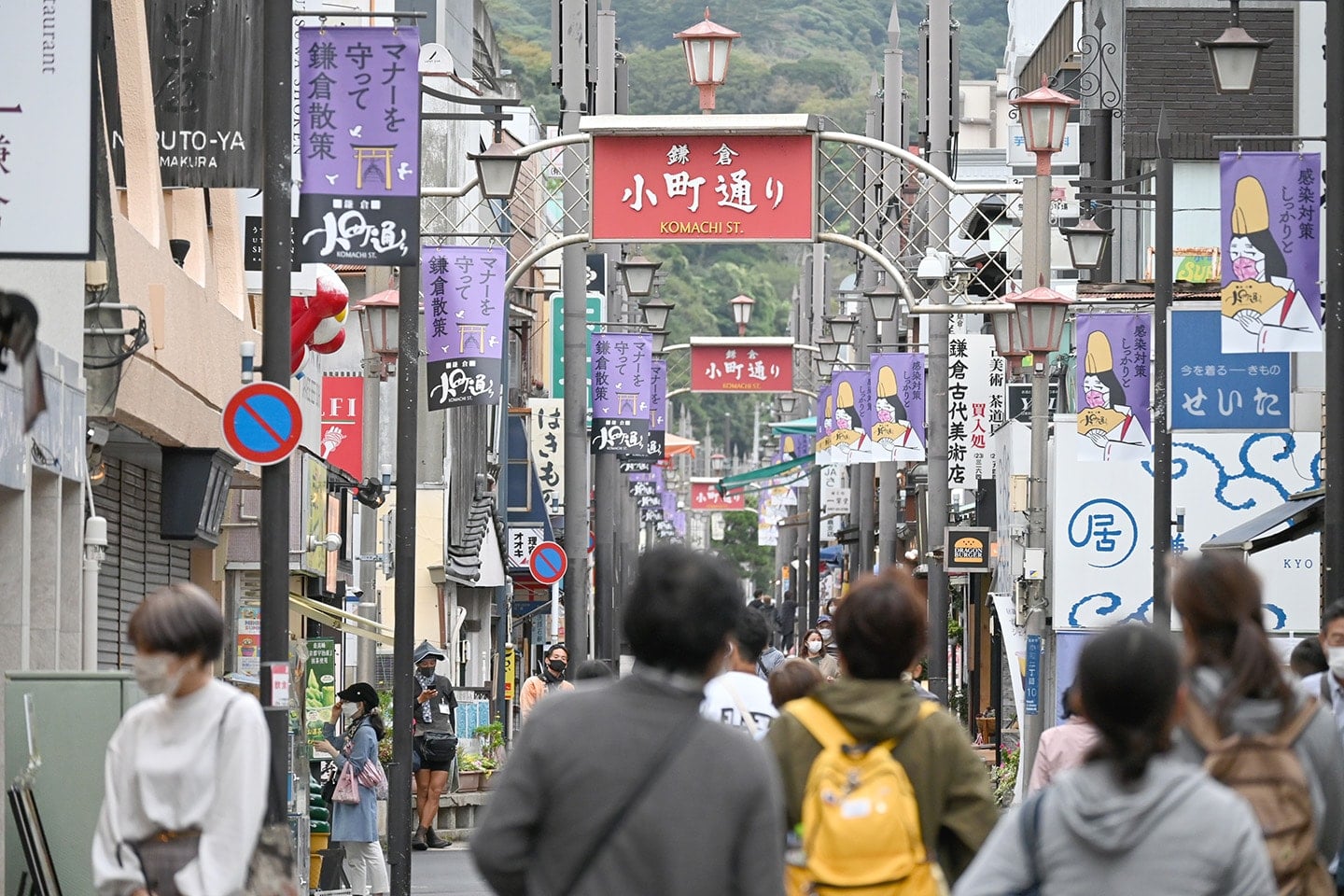
The street is lined with about 250 shops, including restaurants, cafes, and souvenir stores.
Hip cafes serving creative interpretations of Japanese sweets sit alongside traditional shops that have operated for generations, creating a delightful mix that captures the essence of this popular destination. Walking down Komachi Dori provides perfect opportunities to experience local culture between visits to temple grounds and ancient shrines.
Local Insights:
- Best Time: Early morning or late afternoon to avoid crowds
- Must-Try: Kamakura beer, locally-made ice cream, traditional sweets
- Walking Route: Direct path from Kamakura Station, east exit to shrine grounds
Fresh Seafood and Seaside Dining Culture
This coastal city’s location on Sagami Bay ensures access to exceptionally fresh seafood. Local restaurants have developed distinctive preparations that highlight natural flavours while incorporating traditional Japanese techniques. Local specialities include shirasu (tiny white fish) served both raw and lightly cooked, representing this seaside town’s unique culinary identity.
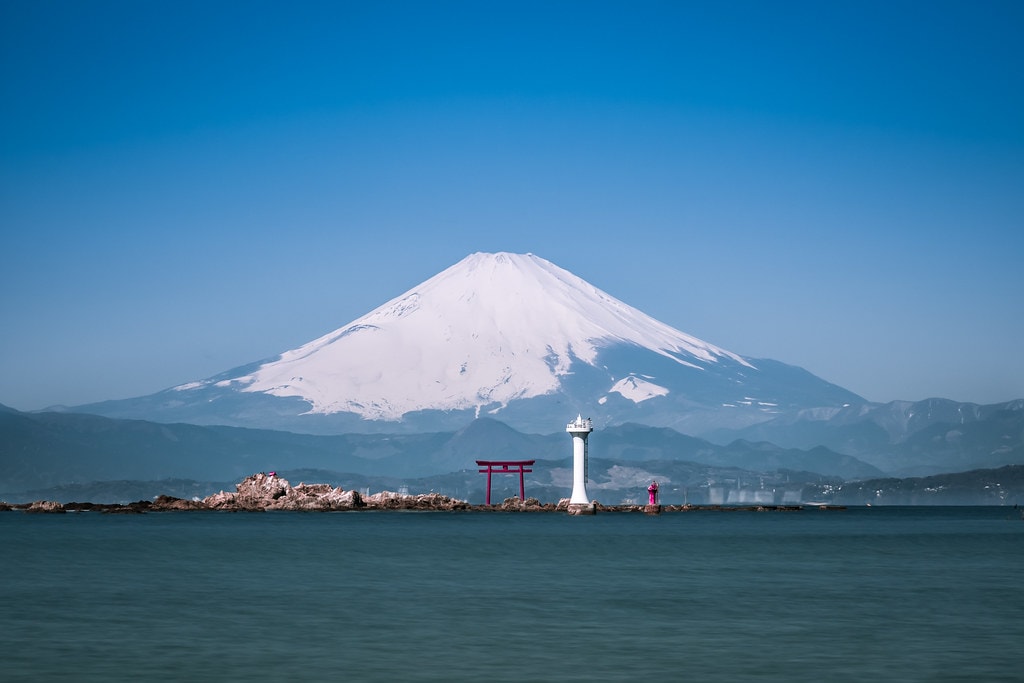
Yuigahama Beach and Shichirigahama Beach are both located on Sagami Bay
The proximity to Tokyo makes this an ideal day trip destination for food enthusiasts seeking authentic coastal cuisine. Many restaurants offer perfect views of Sagami Bay, allowing diners to watch the occasional wave while enjoying the catch of the day.
Culinary Insights:
- Shirasu Season: March-December (raw preparation available March-November)
- Best Areas: Restaurants near Hase Station and along the coastal main road
- Price Range: Casual meals ¥1,500-3,000; upscale dining ¥8,000-15,000+
Unique Cultural Experiences: Traditions Come Alive
Horseback Archery: Ancient Arts in Modern Times
Witness the spectacular art of yabusame (horseback archery) at Tsurugaoka Hachiman Shrine during special festivals, where this ancient practice, essential to samurai training, continues as both a spiritual practice and cultural preservation. Skilled practitioners, dressed in traditional hunting attire, guide their horses at full gallop through the shrine grounds while firing arrows at small wooden targets with remarkable accuracy.
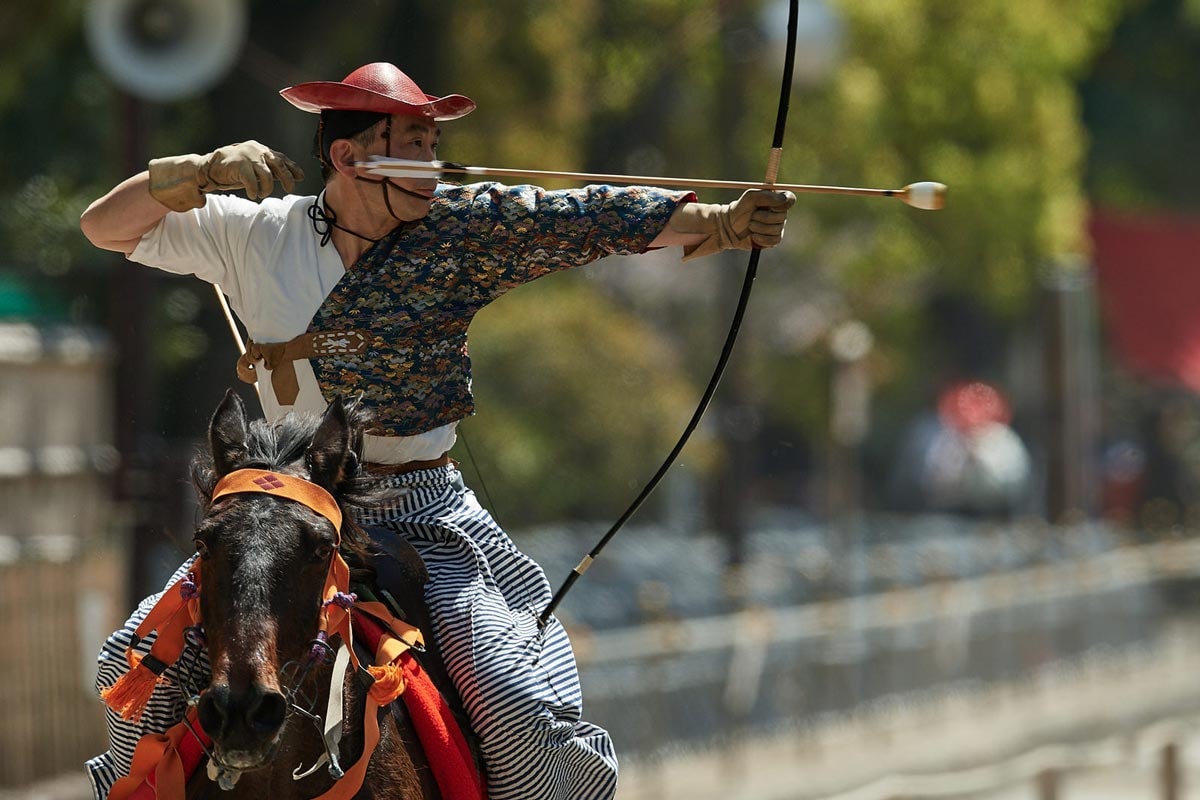
Spring weather is generally pleasant with rising temperatures and limited rainfall.
The horseback archery events represent living history, demonstrating how this seaside town maintains connections to its past as the centre of military government during the Kamakura Shogunate period.
Event Information:
- Major Festivals: September 16 (annual festival) and other special occasions
- Duration: Ceremonies typically last 2-3 hours
- Viewing: Free from designated areas within shrine grounds
National Treasures and Cultural Artefacts
This historic city is home to numerous officially designated national treasures and Important Cultural Properties, representing some of Japan’s finest artistic achievements, which are preserved within temple grounds and shrine complexes. Beyond the famous Great Buddha statue, temples and museums preserve sculpture, paintings, and decorative arts that span centuries of creative development.
Many pieces remain in their original temple settings, allowing visitors to appreciate them in contexts for which they were created during this city’s time as the political capital.
Pop Culture Connections: “Slam Dunk” Pilgrimage
Shichirigahama Beach has achieved international fame as the inspiration for iconic scenes in “Slam Dunk,” one of Japan’s most beloved manga and anime series, featuring the small island of Enoshima in the backdrop . The railway crossing near Shichirigahama Station appears in the series’ opening sequence and has become a pilgrimage site for fans worldwide.
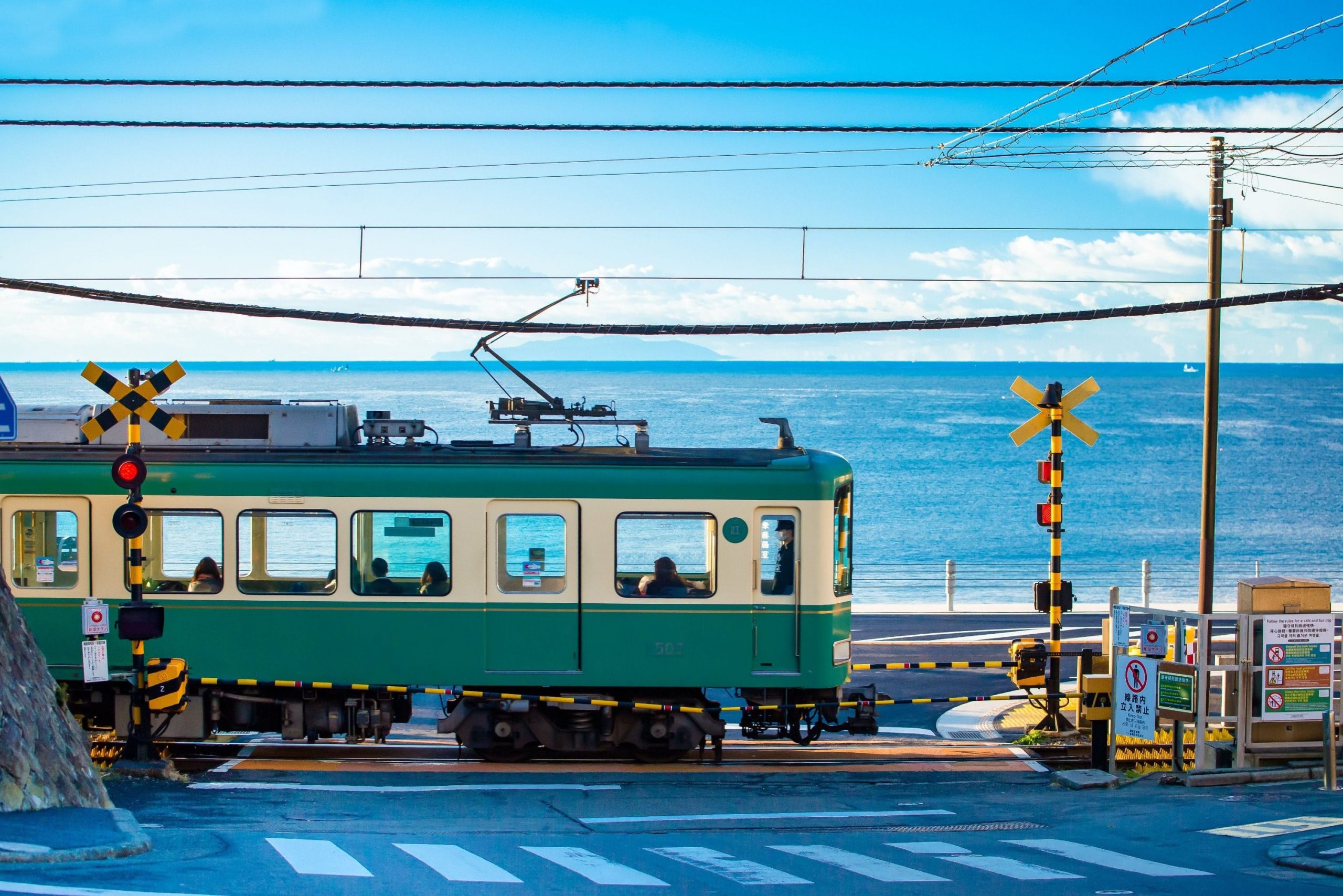
The railway crossing was featured in the opening scene of the “Slam Dunk” anime.
This connection demonstrates how contemporary Japanese popular culture continues to celebrate the country’s natural beauty, creating new reasons for international visitors to appreciate traditional scenic locations.
Essential Travel Information for Your Day Trip from Tokyo
Transportation: Seamless Connections via JR Lines
From Tokyo Station:
- JR Yokosuka Line direct service (approximately 55 minutes)
- Alternative: JR Tokaido Line to Ofuna, transfer to JR Tokaido Main Line (50-60 minutes)
Local Transportation:
- Enoden train: Connects Kamakura Station to coastal attractions, including Hase Station and Shichirigahama
- Walking: Most temple grounds and ancient shrines within a 15-minute walk from stations
- Day passes: Kamakura-Enoshima Pass (¥800) covers unlimited local train travel on the Enoden line
Planning Your Kamakura Day Trip Itinerary
Morning (9:00 AM – 12:00 PM): Start at Kita-Kamakura Station for Engakuji Temple, then take local transportation to the Great Buddha statue at Kotoku-in Temple near Hase Station.
Afternoon (12:00 PM – 4:00 PM): Visit Hasedera Temple for lunch and garden exploration, followed by the bamboo garden at Hokokuji Temple for a tea ceremony experience.
Late Afternoon (4:00 PM – 6:00 PM): Explore Tsurugaoka Hachiman Shrine and walk down Komachi Street for shopping and good food before returning to Kamakura Station.
Optional Beach Extension: Add Yuigahama Beach or Shichirigahama Beach for coastal views and the famous Slam Dunk railway crossing (requires an additional 2-3 hours). These coastal attractions rank among the most refreshing things to do in Kamakura, especially during the summer months.
Best Times to Visit This Popular Destination
Spring (March-May): Cherry blossoms transform temple grounds and shrine complexes, and mild weather is perfect for hiking trails.
Early Summer (June): Rainy season brings spectacular hydrangea displays at Hasedera Temple.
Summer (July-August): Beach shacks open, perfect for combining temple visits with coastal relaxation.
Autumn (September-November): Autumn foliage creates stunning backdrops for Buddha statues and ancient shrines
F.A.Qs
Is Kamakura worth visiting if I only have one day?
Absolutely! Kamakura’s compact size makes it perfect for a day trip from Tokyo. You can comfortably visit the Great Buddha statue, explore Hasedera Temple’s gardens, walk through Tsurugaoka Hachiman Shrine, and stroll Komachi Street in 6-8 hours. The efficient Enoden train connects coastal areas if you want beach time. Many visitors find that one day gives them a great taste of Japan’s spiritual and cultural heritage.
How crowded does Kamakura get, especially on weekends?
Weekends and holidays can be very crowded, particularly during cherry blossom season (March-April) and autumn foliage (November). Temple grounds fill up by midday, and Komachi Street becomes packed. Visit early morning (8-9 AM) or late afternoon for fewer crowds. Weekdays are significantly less busy. The rainy season (June-July) offers beautiful hydrangeas with manageable crowds.
Can I use my JR Pass to get to Kamakura?
Yes! Your JR Pass covers the JR Yokosuka Line from Tokyo Station directly to Kamakura Station. However, the local Enoden train connecting Hase Station (Great Buddha) and coastal areas isn’t covered by JR Pass. Consider buying the Kamakura-Enoshima Pass (¥800) for unlimited local transport, or pay individual fares (¥190-260 per trip) on the Enoden line.
Are there good restaurants near the main temples?
Yes, excellent dining options exist throughout the city. Near Hase Station, try shirasu (local tiny fish) specialities at seaside restaurants. Komachi Street offers everything from traditional sweets to hip cafes. Many temple grounds have on-site tea houses serving Buddhist cuisine with garden views. Beach shacks operate during the summer. Expect to spend ¥1,500-3,000 for good meals featuring fresh seafood.
What should I do if it rains during my visit?
Don’t cancel! The rainy season brings spectacular hydrangeas at Hasedera Temple. Most temple buildings offer covered areas for exploring Buddha statues and national treasures. Browse covered shopping along Komachi Street, enjoy extended tea house experiences, or visit small temple halls with indoor exhibits. Pack an umbrella and waterproof shoes – the gardens look magical in gentle rain, and you’ll encounter fewer crowds.
Create Your Perfect Kamakura Experience
This enchanting seaside town rewards thoughtful exploration with experiences that engage mind, body, and spirit. Whether you’re drawn by ancient shrines, the natural beauty of bamboo forests, cultural traditions preserved in temple grounds, or seaside relaxation along sandy shores, this remarkable destination offers opportunities to create deeply personal travel memories just an hour south of Tokyo.
The city’s compact size allows visitors to design seamless day trip itineraries that flow naturally from temple meditation to coastal walks, from traditional tea house ceremonies to contemporary cultural experiences, such as the Slam Dunk pilgrimage site. The efficient Enoden train system connects all major attractions, while the short walk between many sites makes exploration comfortable and rewarding.
Your journey through this historic political capital becomes more than sightseeing; it transforms into a personal exploration of Japan’s cultural heart, where every temple visit, every moment in the bamboo gardens, and every sunset view over Sagami Bay contribute to an understanding of this extraordinary country’s enduring appeal.
Visit Japan in another place? Check out our guide for your best travel inspiration.
